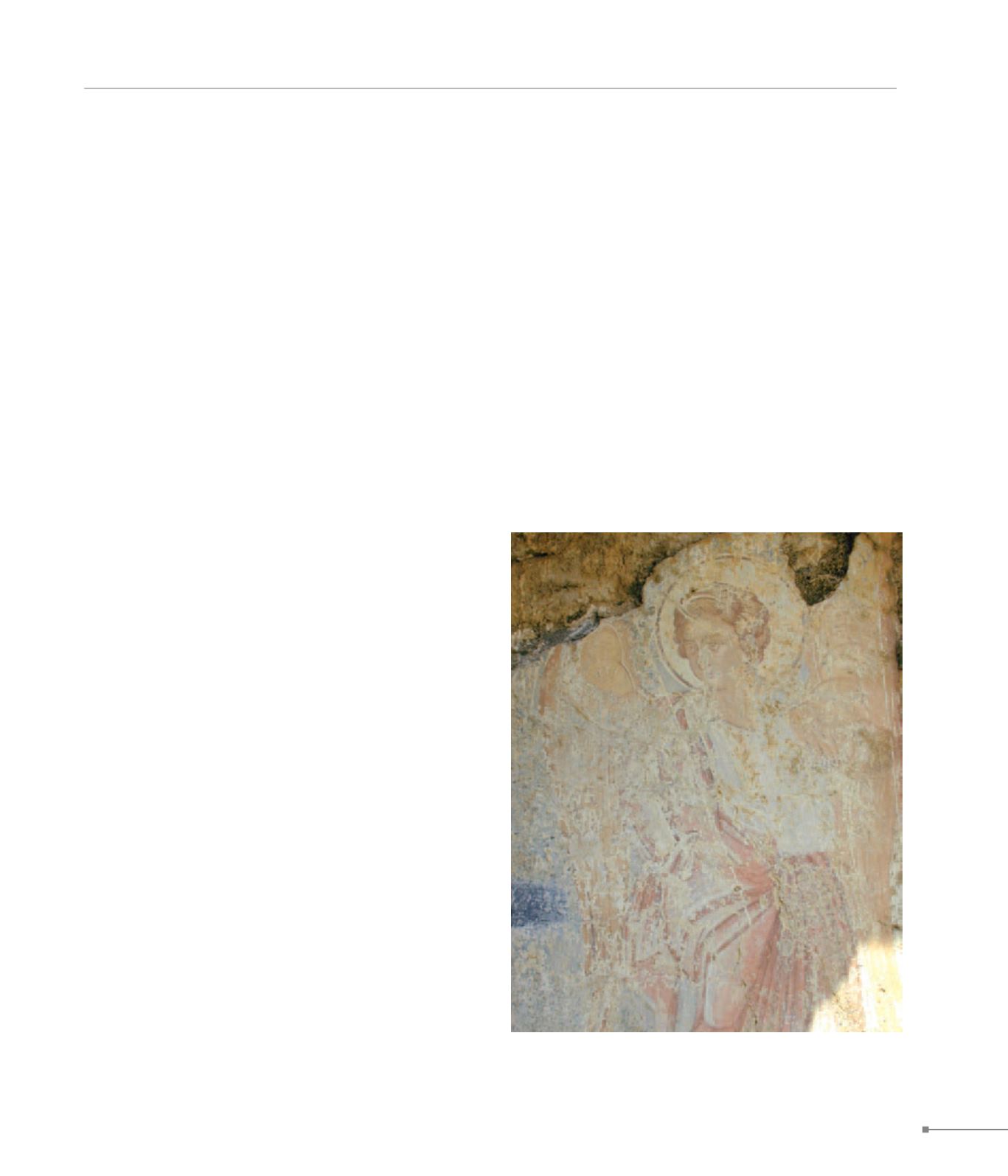
Sarakina.
Kantanos (Kantania).
CRETE
243
354. Kantanos, Treis Ekklesies, Saint George, wall painting (painter
Ioannis Pagomenos) (Κάντανος, Τρεις Εκκλησιές, Άγιος Γεώργιος,
τοιχψογραφία (ζωγράφος Ιωάννης Παγωμένος))
351.
Sarakina.
In Sarakina village stands the church of Saint John Chrys-
ostom with wall-paintings of 1341-9, possibly the work of
the painter who created the second layer of paintings in the
church of Ai kyr-Yiannis at Alikianos. Outside the village is the
church of Archangel Michael, built on the nave of a larger,
three-aisled, timber-roofed Byzantine basilica, of
which
the
apse of the bema is preserved
at
a sufficient height
. The church
features a built altar screen and wall-paintings of the early
14th c. that can be attributed to Ioannis Pagomenos et al. The
folk decoration of the church of Aghia Paraskevi at Chondros
dates from the first half of the 15th c.
352.
Kakodiki.
Near Kadros survive the ruins of an ancient city that continued
to flourish in the Early Christian period, as indicated by the
scattered sculptures found in various churches. The church
of Archangel Michael is barrel-vaulted and single-nave with a
characteristic Late Gothic doorframe; its decoration can be at-
tributed to an artist of the mid-15th c. The church of the Soter
was frescoed in the late 14th c. and the church of Saint John
Chrysostom at Kadros in the mid-15th c. The decoration of
Panagia is the work of Ioannis Pagomenos and his associates.
The church of Aghios Isidoros at Tzeneliana dates from 1420-
1. The ruined church of Panagia at Beilitika, whose upper sec-
tions have been reconstructed, was decorated in 1331-2 by
Ioannis Pagomenos.
353.
Plemeniana.
The funerary church of the Soter is built at the site of an Early
Christian basilica, as indicated by the sculptures that are in-
corporated in the walls or are displayed in the church. The
building was extended W in the 19th c. and the wall-paintings,
the work of three artists, date from the late 13th c. The barrel-
vaulted, single-nave church of Saint George was painted in
1458. The church of Panagia at Tzevremiana features sculpt-
ed elements incorporated from an Early Christian church. Its
decoration dates from the mid-15th c. In Kopetoi district the
ruined church of Aghioi Apostoloi, which has recently been
restored, was decorated by painter Ioannis Pagomenos in the
first decades of the 14th c, as well as the church of Saint John
Theologos. The church of Aghioi Apostoloi at Drys, among im-
ages from the second half of the 15th c., features the scene of
Saint Bartholomew with his own flayed skin on his shoulders.
354.
Kantanos (Kantania).
This Early Christian see of Kantanos or Kantania has a pleth-
ora of spolia from the period surviving in local churches. Re-
mains of basilicas are preserved beneath the churches of Saint
George at Benoudiana and of Saint Catherine in the centre of
Kantanos. In the town and the surrounding settlements are ap-
proximately forty small, barrel-vaulted, single-nave churches
with wall-paintings dating from between the second half of the
13th c. and the mid-15th c., usually comprising votive offer-
ings, as indicated by inscriptions. In central Kantanos, at the
church of Saint Nicholas (also known as the “mosque”) wall-
paintings of the early 14th c. created by Ioannis Pagomenos
have been uncovered. At a short distance are the decorated
single-nave churches of Saint Catherine, Aghia Paraskevi,
Saint Anthony, and Aghioi Apostoloi (14th c.). The ruined
church of Saint George at Benoudiana was built in the place
of two earlier ones, whose apses can be distinguished below
the latest apse. The wall-paintings were created by Theodoros
Daniel Veneris circa the late 13th c. At Anisaraki are the single-
nave churches of Aghia Paraskevi with frescoes by Ioannis


